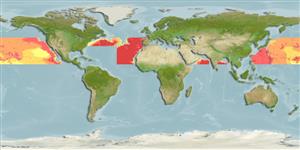Teleostei (teleosts) >
Alepocephaliformes (Slickheads and tubeshoulders.) >
Alepocephalidae (Slickheads)
Etymology: Einara: After Einar Lönnberg, Swedish zoologist; 1865-1924.
Eponymy: Einar Koefoed (1875–1963) was a Danish-born marine biologist, though much of his work was done in Norway. He took part in the ‘Michael Sars’ (q.v.) expedition of 1910, and was a pioneer researcher on Atlantic species such as the Pollack (1932). (Ref. 128868), visit book page.
More on author: Alcock.
Environment: milieu / climate zone / depth range / distribution range
Ecology
Marine; bathypelagic; depth range 700 - 2000 m (Ref. 4460). Deep-water; 45°N - 13°N, 180°W - 180°E
Eastern Atlantic: isolated records between Morocco and Madeira Island and south-west of Azores Island. Western Atlantic: off George's Bank. Elsewhere, Indian Ocean and eastern and western Pacific.
Size / Weight / Age
Maturity: Lm ? range ? - ? cm
Max length : 20.3 cm SL male/unsexed; (Ref. 4460)
Life cycle and mating behavior
Maturity | Reproduction | Spawning | Eggs | Fecundity | Larvae
Markle, D.F. and J.-C. Quéro, 1984. Alepocephalidae (including Bathylaconidae, Bathyprionidae). p. 228-253. In P.J.P. Whitehead, M.-L. Bauchot, J.-C. Hureau, J. Nielsen and E. Tortonese (eds.) Fishes of the North-eastern Atlantic and the Mediterranean. UNESCO, Paris. Vol. 1. (Ref. 4736)
IUCN Red List Status (Ref. 130435: Version 2024-1)
Threat to humans
Harmless
Human uses
Fisheries: of no interest
Tools
Special reports
Download XML
Internet sources
Estimates based on models
Preferred temperature (Ref.
123201): 3.4 - 4.1, mean 3.6 °C (based on 23 cells).
Phylogenetic diversity index (Ref.
82804): PD
50 = 0.7500 [Uniqueness, from 0.5 = low to 2.0 = high].
Bayesian length-weight: a=0.00347 (0.00163 - 0.00737), b=3.19 (3.00 - 3.38), in cm total length, based on LWR estimates for this (Sub)family-body shape (Ref.
93245).
Trophic level (Ref.
69278): 3.4 ±0.5 se; based on size and trophs of closest relatives
Resilience (Ref.
120179): Medium, minimum population doubling time 1.4 - 4.4 years (Assuming tmax>3).
Fishing Vulnerability (Ref.
59153): Low vulnerability (15 of 100).
